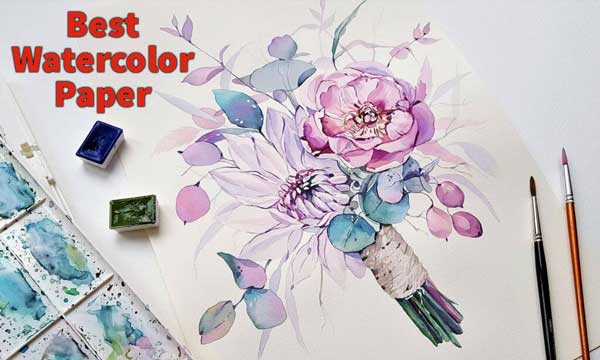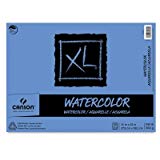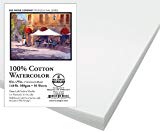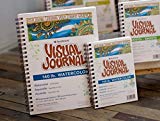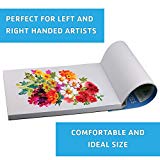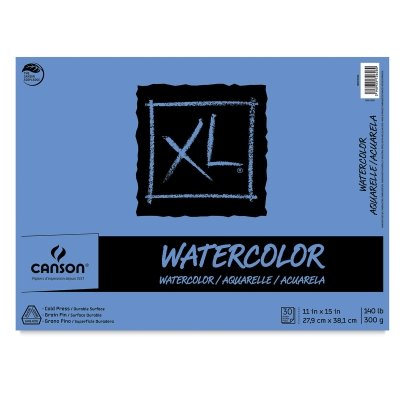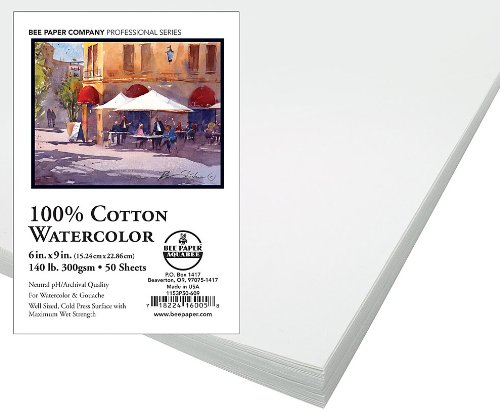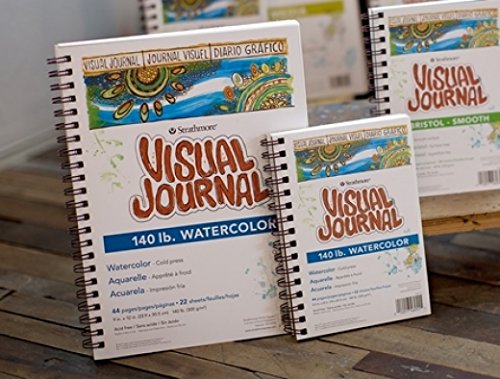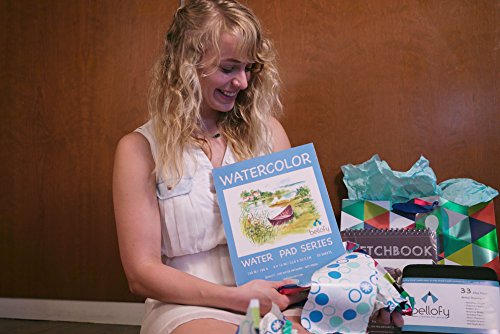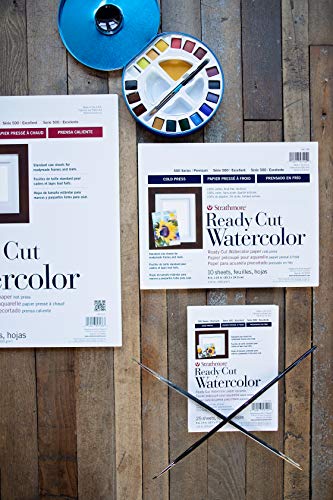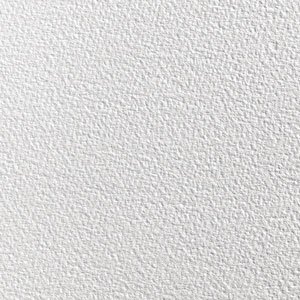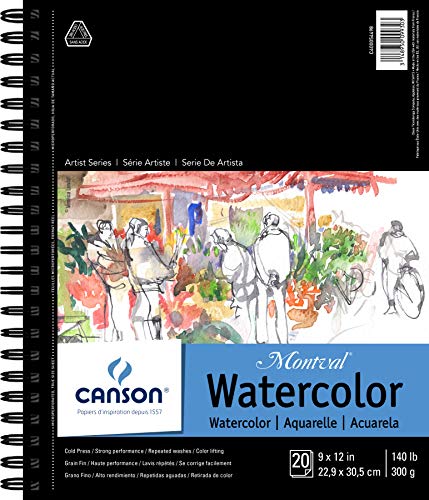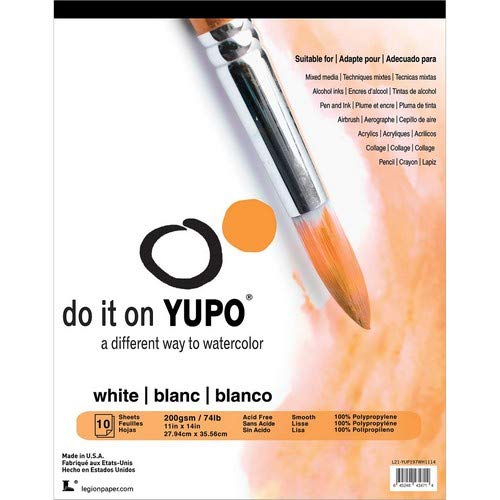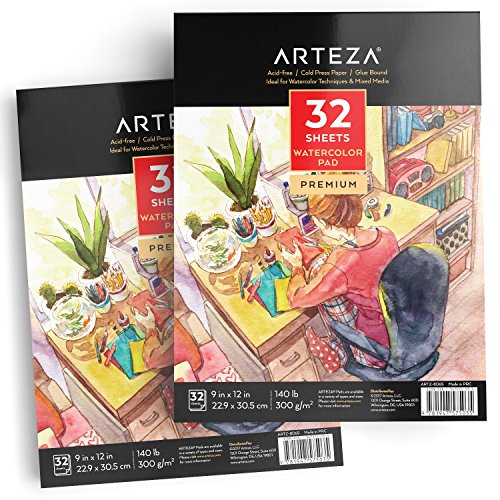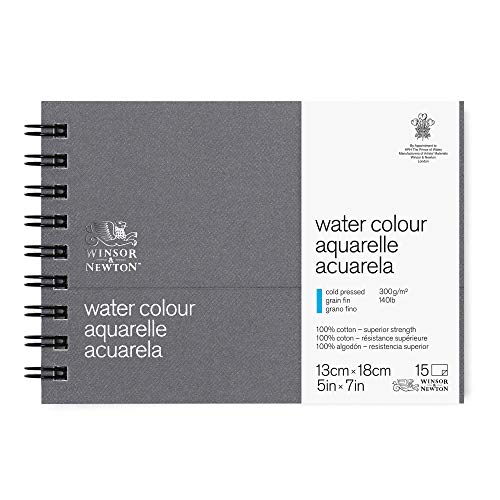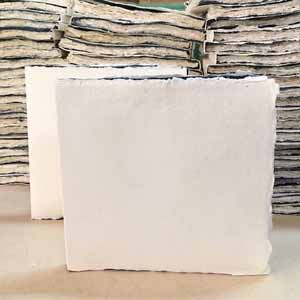Top 13 Best Watercolor Paper Reviews For Beginners and Experts
Katheryn graduated from high school in 2013, but as fate would have it, she’d get knocked up by a guy who’d disappear soon after Katy (as we like to call her) gave birth.
She had no way of tracing him, and as she hadn’t gotten a job yet, life became pretty hard for her. Her parents weren’t so well off, so she had to struggle to provide for her little one, jumping from one cleaning job to the next.
In 2016, Katy met an employer who was into watercolor painting, and he was generous enough to show her the ropes and teach her a thing or two about online selling.
Today, Katy owns a house in Tennessee and a she’s able to provide for her kid and her old parents. She paints exquisite pieces and sells them online, and because of her awesome marketing skills, Katy has a substantial following and a swarm of loyal customers.
If you are (or are looking to be) a watercolor painter, there’s something should know – it’s not just the paint that determines the quality of the final artwork; the paper used also plays a central role. You cannot use ordinary paper like computer paper or drawing paper and hope that the painting will be great; you need the best watercolor papers.
We’re going to tell you about Katheryn’s preferred watercolor papers as well as a few other good ones we’ve come across, and we’re confident you will be a successful professional or hobby watercolor painter.
Let’ get to it.
Image | Name | Editor's Rating | Price |
|---|---|---|---|
5 out of 5 | |||
5 out of 5 | |||
4 out of 5 | |||
5 out of 5 | |||
4.5 out of 5 |
Table of Contents
Why We Need to Use Watercolor Paper Specially?
Regular paper is manufactured from wood fibers. It is thin and lightweight and absorbs pigment a lot faster than watercolor paper.
Watercolor painting brings water into the picture, and hence, when ordinary paper is used, it absorbs the pigment rapidly and warps. It also tears with ease due to the dampness, meaning the whole project is quite tricky to complete successfully.
Special watercolor paper, on the other hand, is made from cotton fibers (it might be pure cotton or blended with wood pulp).
This paper is heavier than ordinary paper and also a bit rougher, and hence it absorbs the pigment at just the right rate and doesn’t get ripped by the dampness.
For these reasons and others, watercolor paper is the ideal type of paper for someone who wants to produce beautiful artwork.
Without further ado, let’s go through the top quality watercolor papers on the market right now.
Our Top 13 Best Watercolor Paper Reviews 2023
1. Canson Arches Cold Press Pads
When you’re looking for the best paper for watercolor, you should definitely consider getting one that is pure cotton. Such a paper is easy to paint on, and its absorption capacity is high.
Majority of the artists we spoke to said the Canson Arches Cold Press pads were their most preferred watercolor papers. In a bit, we’ll share with you some of the reasons they gave.
First of all, these papers are manufactured by Arches, which is arguably the most respected brands in the industry. As the brand has been in the paper milling industry for a couple hundred years, you can just imagine the amount of knowledge pertinent to paper making it has accumulated.
It’s no wonder its products are of such high quality.
These watercolor papers are made using the original, traditional ways, on a cylinder mold, and for that, the grain comes out naturally and in a harmonious manner.
When you want to preserve artwork for a long time, then there’s something you need to watch out for – does the paper contain the active acid pulp. If it does, then the acidity will disintegrate the artwork, leading to low durability.
During the manufacturing process, the materials used to make the Canson Arches Cold Press are ridded of the acid pulp, so you can depend on these papers to preserve your artwork for a long time.
Still for longevity, the papers are treated with antimicrobial agents, which help them to resist mildew.
Highlighted Features:
2. Canson XL Series
The Canson XL Series is a 140-lb (300 gsm) watercolor pad that contains 30 sheets measuring 11 by 15 inches. If 30 premium quality watercolor paper sheets going for less than 20 bucks is not affordable, then we don’t know what is.
The Canson paper millers have been in the business since the 16th century, meaning they’re pretty old and experienced. That’s why the quality of their watercolor papers is so excellent.
Although the label says that the paper is cold pressed, if you open the pad and take a close look at the paper, you will realize that it’s smoother than what you’d naturally describe as cold pressed watercolor paper.
It’s not smooth enough to be called hot pressed; it’s somewhere in the middle. This design, is beneficial because it helps you paint and at the same time draw fine lines with relatively good results.
It also aids the blending in of the paint colors.
As the papers are acid-free, they hold your artwork for years on end, so you will love that longevity.
The Canson XL papers are designed by professors of art and they’re assessed for performance on different media. They receive colors beautifully and hold them well so they don’t fade.
We wouldn’t really recommend the pads for professional painting but if you’re a student or if you’re a hobbyist, you’ll find them quite useful.
Highlighted Features:
3. Bee Paper Pack
If you keep watercolor sketchbooks, then you’ll probably find the 6 by 9-inch size of this watercolor paper appropriate.
What’s more, the cost is much better than purchasing full artist-grade pure cotton papers. At just around 15 bucks, this pack (of 50 sheets) is absolutely budget-friendly.
Factoring in the fact that you won’t have to cut the full sheets, which translates to time efficiency, it’s easy to see that the Bee Paper Pack is a perfect deal.
If you have used watercolor paper before or have been researching about them, then you’ve probably heard about the importance of the weight/thickness of the paper. Well, tell you what? This paper from Bee has a weight of 140lb, meaning its thickness is adequate for withstanding warping.
Note, it’s not the sheets contained in the pack that weigh 140 pounds but rather a ream (500 sheets) of Bee watercolor paper. Anything that is 140lb or over is considered watercolor-grade.
As you’ll discover later in the buying guide, it’s always good to consider the material used for making the paper. 100% cotton, which is the material used for this paper, happens to be the best as it is resilient to deterioration and also easy to paint on.
Many artists are pleased with this paper, and some even compare its performance to that of popular brands like Arches.
If you’re looking for an inexpensive but high-grade paper that won’t buckle and that will preserve your artwork for many years, then try the Bee Paper.
Highlighted Features:
The Strathmore 400 Series can take a really heavy wash, and that for us makes it the best watercolor paper for beginners and experts alike.
If your designs involve lots of paint and water, and you have tried other watercolor papers that buckled due to the dampness, then you got to give Strathmore’s paper a shot.
Another advantage is that the paper doesn’t bleed or pill when coated with water.
The paper is fairly rough, and this makes it possible to create artwork with a good degree of texture.
If you’re looking for the perfect watercolor journal, then the longevity is one of the factors you need to consider. This Strathmore sketchbook has got you covered with a hard cover that holds out really good.
By tearing off the top covering, you reveal the brown cover, which is a sturdy protection for the papers inside.
The paper itself is textured, just as cold pressed paper should be. It’s also a bit thick, and this is what helps is out to warping. If you’re going to use various brushes and paint on it, then you’re in luck because the paper is compatible with most watercoloring brushes and paints.
There’s one thing though that you should keep in mind when buying this paper – it is half the size of the standard letter paper sheet.
For that reason, we’d recommend it only for painting flowers and other small-size sketches.
Highlighted Features:
If you’re a student or you’re only getting started with watercolor painting, there’s no need to get a premium-quality paper.
It’d be better to purchase a student-grade paper because that way you’ll not use as much money. After all, you’re only in the learning stage.
The paper is 130lb, meaning it is not heavy enough to withstand too much water. If you apply too much water on it, the paper will warp, and your painting will not come out very well.
But if you’re only doing little sketches or paintings that don’t involve too detail, then the paper will work out well.
The papers are arranged in a pad and glued on one side. This convenient arrangement allows you to flip the pages smoothly and also makes it easy to detach them.
Being made from wood pulp means that the paper is not as durable as pure cotton paper. However, the paper is ridded of the acids, which happen to be one of the central elements of deterioration.
Although the paper isn’t as sturdy as artist-grade 100%-cotton paper, it is still long-lasting and will serve a learner well.
The paper is not very strong, so you don’t want to tape it down. Furthermore, you might see a little bit of damage after removing masking from it, but other than that, the wet on wet performance is fairly good.
The manufacturer calls it cold pressed, but that’s not really the case. We like to think of it as something between hot and cold pressed. Not bumpy but not completely smooth either.
Highlighted Features:
Stathmore is one of the most preferred brands in the watercolor paper industry, and you can never go wrong buying from it.
Up to this point, we’ve only talked about cold pressed or at least mildly rough paper. In case hot pressed paper is what you need, then this Strathmore paper could be it.
It has a smooth surface that enables you to create fine sketches and displays the drawing vividly.
Measuring 5 by 7 inches, the Strathmore 140-305 500 Series paper is for those of you who want to do small-sized sketches like flowers. With a weight of 140 pounds, the paper is strong and thick enough to withstand heavy washes.
The paper is also robust enough to be taped down without crushing or getting distorted in other ways.
If you’re a budget-minded buyer looking for the most affordable paper for your watercoloring projects, then you should definitely consider getting this one. A pack containing 25 sheets that goes for just around 7 dollars is certainly a good deal.
Any seasoned watercolor artist will tell you just how much the material of the paper matters. This particular paper is made of 100% cotton, which not only enables it to absorb paint and display the image beautifully but also gives it the strength to withstand heavy washes.
Acid is one of the elements that cause deterioration of paper, and as it’s totally absent in this paper, the product is long lasting and acts as a reliable substrate for designs.
Highlighted Features:
Many artists out there will tell you that Arches is the best brand. For those of you who want a block rather than a pad, the Arches Watercolor Block is undoubtedly the perfect choice.
The papers are glued together on all sides and held as a block, and the advantage is that you won’t have to tape them down while painting. The block holds the paper for you, ensuring it is stable.
In addition to that, removing the papers is easy. All you need to do is stick a palette knife in the slit underneath and go around the paper.
What about the quality of the paper? You ask. Well, first of all, the paper is made of 100% natural cotton fibers.
Moreover, it’s not made by machine. Instead, it’s made in a cylinder mold, ensuring the quality is top-notch.
The weight of the paper (which is expressed as the weight of the ream or rather 500 sheets) also matters a lot when choosing a watercolor paper. Anything that is 140-pound or more is considered heavy and good enough for professional watercoloring.
You’ll be glad to know that the Arches Watercolor Block is 140-pound.
The tooth of the paper is something artists are in love with. Being cold pressed, it has a relatively rough surface.
The nice consistency of the texture enables the paper to hold the watercolor beautifully and gives you some time to work the paint so you can blend the colors as you like.
Highlighted Features:
Looking for good watercolor paper for practice? The Canson Artist Series will serve you excellently. This is a paper pad that includes 20 sheets held together on one side.
The papers measure 9 by 12 inches, so you have enough room for small to medium-sized paintings.
Unlike other student-quality papers, this one is really good and could even be used professionally. Not the best for professional purposes but it’s definitely good.
It performs beautifully on wet media, withstanding erasing, scraping, and repeated washes. Being microperforated and cold pressed with an even grain, the paper is able to absorb the water efficiently without bleeding or pilling.
The ream weight of this paper is 140 lb, and as you might already know by now, 140 pounds or more is considered sufficient for professional watercolor painting.
Pulp acids lead to the fast degradation of paper. This paper might not be 100% cotton, but at least you have the peace of mind of knowing that the pulp acids are removed.
As the paper is acid-free, it preserves you beautifully artwork for a long time.
If you’re on a tight budget, this paper should certainly be among your top choices. You get 20 good sheets at a price of less than 10 bucks.
Like any good watercolor paper, this paper is not machine-made. It’s mold-made, meaning that high standards of manufacturing are used.
Highlighted Features:
Planning to send a postcard? Why not do it in style by sending your own artwork in a watercolor-painted postcard?
The Strathmore Watercolor Postcards offer you the perfect deal for the money, as you have to pay just over 10 bucks. And it’s not one pad; it’s three pads, and each pad contains 15 postcards. So, you get 45 blank postcards for just over 10 dollars. Isn’t that amazing?
Each of the cards measures 4 by 6 inches, giving you enough room for painting while keeping the size small enough to be sent as a postcard.
What of the quality? You’ll be glad to know that the cards are manufactured in the US, by a company that has been in operation for quite some time. Strathmore is a top brand and buying from them is definitely a good move.
The paper is made of natural cotton, and something even more amazing is that there are no pulp acids in there.
Because of the quality cotton material, as well as the acid-free condition, the paper does not deteriorate as fast as regular paper. It keeps your artwork intact for years.
The paper is almost cold pressed. Its surface isn’t very rough as you’d expect a cold pressed paper to be, but it still has a nice tooth that supports the good absorption of paint while still giving you the ability to sketch without too much difficulty.
It has a 140-pound ream weight, denoting it’s thick enough and able to withstand many washes without the problem of buckling.
Highlighted Features:
The Legion Paper Watercolor paper is a little different from other watercolor paper in that it’s not made from cotton or tree pulp; it’s rather made from Yupo.
Yupo is a synthetic paper that is tree-free and waterproof. The material is resistant to water, and thus it doesn’t absorb the paint as other watercolor papers do. Instead of the water soaking into the material, it settles on top and dries up there, forming nice textures.
The material is comparable with hot pressed paper, perhaps even better. It displays the image brightly and beautifully.
It’s natural to expect that because the material doesn’t suck up the paint, the design won’t last long, but that’s not really the case. The painting remains intact for a long time; not quite as long-lasting as cold pressed paper paintings but still durable.
There are no acids in the Yupo paper, and that means one of the biggest causes of paper degradation is absent. This is another aspect that helps the paper last a long time.
The pad contains 10 sheets measuring 11 by 14 inches. Going for under 20 bucks, we believe that’s a fair deal for watercolorist on a budget who needs Yupo paper. If you want to paint large-size designs, 11 by 14 inches should be adequate.
The paper works great with paints and brushes, but how does the paper work with graphite pencils? You ask. Well, we’re happy to inform you that the Legion Paper Watercolor paper works great with graphite pencils. It’s good for sketching.
Highlighted Features:
At first glance, you’d think that this product is expensive but a closer look reveals things from a different angle.
When it comes to value for the money, the ARTEZA Watercolor Pack is one of the top products. It comes as a pack of 2, with each pack containing 32 sheets. So, that’s a total of 64 sheets going for just over 20 dollars. If that’s not budget-friendly, then we don’t know what is.
Even though the product is on the cheaper side with regards to the price, the quality is pretty superior. If you’re a professional looking to come up with some magnificent artworks, you won’t be making a mistake to buy this pack.
The papers are made from pure cotton, and apart from that, they’re free of acids. That denotes that your work will last years and you don’t have to worry about the deterioration that comes with acids and other impurities.
The paper is cold pressed, but the texture is not too rough; it’s got just the right tooth for moderate paint absorption.
Moreover, the grain is uniform, meaning that the application comes out smoothly and evenly. If you’re looking to produce an exceptional painting, these features will be very useful.
Fading is not a problem you have to worry about when using this paper. We already mentioned that it’s made from cotton and doesn’t contain acids. That means there’s nothing to deteriorate the rich vibrance of the colors.
Heavyweight paper is what you want to use for watercolor painting. The ARTEZA Watercolor paper’s ream weight is 140 pounds, which makes it good enough for watercoloring.
Highlighted Features:
When it comes to durability and resilience, the Winsor & Newton Watercolor Paper Journal is unmatched.
Made in a cylinder mold, this paper is extremely strong, withstanding repeated washes without warping or pilling.
The paper is made of interwoven fibers, making sure it stays strong and intact. One user said the paper is “perfect for the artist”, and we believe it’s something a professional would benefit a lot from.
Because of the internal and external sizing of the fibers coupled with the fact that the paper is made from cotton, the colors remain vibrant even after the paint dries up.
By the by, we’re not talking of cotton blend. It is 100% cotton without acids. 100% cotton means the absorption rate is at the right level and it also implies longevity.
Being cold pressed with a tooth/texture that is just right and uniform as well, the paper allows the paint to soak in but not so much as to make the painting looks clumsy. The finish reduces the coarseness, and thus the painting is depicted as though it’s on hot pressed paper. The colors come out brilliant.
The pad contains 15 sheets of paper measuring 5 by 7 inches. Some people might say that the price is too high for 15 sheets but if you use this paper, you’ll quickly realize it’s worth every dime.
No bleeding or pilling and the color control offered is exceptional.
Highlighted Features:
13. Khadi Handmade Watercolor Pad
If you’re a learner in need of a no-fuss but good and easy to use watercolor paper, then you got to try the Khadi Handmade Watercolor Pad.
This pad comes as a stack of 30 sheets held together on one side. Each of the sheets measures around 6 by 6 inches, which is good for creating little painted designs.
For the budget-minded buyer, the Khadi Handmade Watercolor papers present a super nice deal. You get 30 sheets at the discounted price of just about 6 bucks.
The texture of the paper is coarse; a little rougher than what you’d call cold pressed paper. This rough surface may not be good for sketching with a marker or a graphite pencil, but it’s okay for paint brushes.
It portrays the painting brilliantly. If you’re looking to bring out an outstanding texture, this paper will certainly be an ideal choice.
The rough texture is great for learning, as it gives you some water control.
As a beginner, you’d be overwhelmed to have to deal with slow-drying paint on a smooth surface.
The weight of the paper is an essential factor to consider, and we hate to break it to you, but this paper’s weight isn’t something you’d want to rely on for professional watercoloring.
The ream weight is just around 80 lb, which is way below the recommended minimum for watercoloring (140 pounds).
But don’t be too quick to brush off the paper because of the weight. It’s obviously not sufficient for a professional’s needs, but remember, the paper is student-quality. It will still come in handy for your learning needs.
Highlighted Features:
What Is Water Color Paper?
Watercolor painting is not done on just any paper; it’s done on a substrate known as watercolor paper, which is manufactured from cotton or a blend of cotton and wood pulp.
Though the pure cotton varieties are a bit more expensive than the blended varieties, they’re the best as they absorb the paint efficiently and hold the artwork beautifully.
But we wouldn’t be helping you understand what watercolor paper is without telling you what differentiates it from ordinary paper, would we?
Here are a few ways in which watercolor paper differs from regular paper like drawing paper or computer paper.
Material
Regular paper is normally made from cellulose fibers obtained from grass, rags, or wood. Sometimes the fibers are mixed with a little bit of cotton to enhance the feel and appearance.
As watercolor paper needs to be tougher and more absorbent and resistant to warping when exposed to moisture, it is manufactured from either pure cotton or a cotton-wood pulp blend.
Thickness
The thickness is pretty much the same thing as the weight of the paper. Generally, watercolor paper’s thickness/weight is more than that of ordinary paper.
On the packaging, you’ll probably find a number indicating the weight, for instance, 300g. The more the weight, the better the quality.
Texture/tooth
When you hear people saying the tooth or bumps of the paper, they’re just referring to the texture. The rougher the texture, the more absorbent the paper is.
While regular paper such as Bristol paper is totally smooth, watercolor paper has lots of bumps to aid the drying process of the paint as well as the absorption process.
Watercolor Paper Buying Guide in 2023

Watercolor paper is available in different forms and qualities that react differently to varying paints and techniques of painting.
How do you find the paper that suits your watercoloring needs perfectly? Here are a few considerations to make.
Quality
As mentioned before, the major grades are – student and professional/artist quality.
Professional grade watercolor paper has superior quality like being acid free, treated with anti-mildew agents, and being more long-lasting. They’re also made from pure cotton, which makes it possible to draw beautiful, durable designs.
Student-quality paper, on the contrary, is designed for experimented, and they’re better suited for students and rookies but not seasoned professional painters.
This paper is normally made from a blend of wood pulp and cotton, so as you’d expect, the performance is not as good. The painting also won’t last as long as something drawn on pure-cotton professional-grade paper.
Manufacturing process
Watercolor paper can be manufactured in three different ways – by hand, by mold cylinder or by machine.
The paper made by hand ranks the best, closely followed by the one made in mold cylinders. The two types of watercolor paper are long-lasting and stable and they display the painting beautifully. Professional-grade watercolor paper is usually made using one of these two methods.
Machine-made paper is cheaper, and therefore, more susceptible to warping and deterioration especially when it’s exposed to moisture. Student-grade paper is normally machine-made.
Material
As said before, watercolor paper can be made from pure cotton or a mixture of cotton and cellulose fibers derived from various sources like grass, rags or wood pulp.
Pure cotton paper is more expensive than paper that is blended with other materials, but it performs better and is more resilient.
Weight/thickness
People get a little confused when it comes to the weight of watercolor paper. You might find a number like 140lb on a packaging containing 30 sheets and wonder how that is so. Well, it’s not the 30 sheets that weigh 140 pounds but rather the ream. That is 500 such sheets.
With watercolor paper, the more the weight, the better the quality as more weight reduces buckling and wrinkling. Basically, a weight less than 140 pounds is considered light while 300 to 400 pounds is considered heavy.
Note – the weight also infers to the thickness. The more the weight, the more the thickness.
Texture
Heard of the terms hot pressed and cold pressed? These refer to the texture of the paper.
Hot pressed paper is smooth with a hard surface. This type is suitable for detailed drawings and fine line drawing as you don’t have to deal with the bumps.
On the flipside, hot pressed paper is slippery, and it makes it a bit difficult to control the paint.
Cold pressed paper has a rougher texture, which is sometimes referred to as semi-rough. The bumps cause the ink to be absorbed a bit faster, giving you more control of the paint.
Going a step higher, we have rough paper, whose surface is even rougher than that of cold pressed paper. If you want your painting to have more luminosity, then rough paper would be a great choice.
Different Types of Papers for Water Coloring(Video)
We hate to break it to you, but watercolor is not very easy for beginners. Getting the watercolor paper wrong makes it even more difficult, so you want to make sure you’re using the right type of paper for your specific project. There are various ways of sorting watercolor paper, and we’re going to do our best to help you understand them.
Student and professional grade
These terms are used to refer to the quality of the paper.
Student grade paper is meant for experimenting and learning purposes, and thus its quality is not as good as that of professional grade paper. For that, it’s also cheaper.
As you can imagine, professional grade paper is of better quality and can take lots of abuse as opposed to student grade paper. This paper, is needless to say, more expensive.
Pad and blocks
The second way of classifying watercolor paper is by the packaging used. This paper is usually sold either in pads or blocks.
Pads are a stack of papers held together on one side. As these papers are free on all but one edge, you have to remove them and stick them down with masking tape while drawing to give them stability and prevent buckling. The advantage with pads is that they’re cheaper.
Blocks are different in that they’re glued on all the four sides. As the papers are already well secured and stabilized, they don’t have to be stuck down with masking tape. You can just paint and then remove the paper.
Removal is done by sticking a small palette knife or mail opener in the slit underneath and cutting all round.
Blocks are ideal for larger paintings because the arrangement prevents the papers from buckling and provides greater stability.
Hot and cold pressed
And lastly, watercolor paper can be categorized based on the texture.
Hot pressed paper is smoother to the touch than cold pressed paper. Its texture is more like that of drawing paper.
In contrast, cold pressed paper is bumpy.
So why does the texture matter? Because it determines whether the paper suits your project.
Due to its smooth texture, hot pressed paper is great for detail line work and inking. With this sort of paper, you won’t have to fight through those little bumps and grooves that you’d find on cold pressed paper.
Furthermore, hot pressed paper doesn’t absorb water as quickly, so the paint will just sit there for some time, allowing you to play around with it. That way, you have more time to experiment with more colors and tweak your design before the paint finally dries.
Fixing mistakes is a lot easier when you’re using hot pressed paper.
Cold pressed paper, with its rougher texture and spongy nature, absorbs paint more quickly. Though you still have some time to play around with the paint, the drying process is much faster, so there’s less room for mistakes.
The benefit that comes with cold pressed paper is that it gives the artist more water control while painting, and for that, it’s more popular than hot pressed paper.
Remember, the type of watercolor paper you use boils down to your personal preferences and the sort of project you’re dealing with.
Top Water Color Paper Brands on The Market
Buying by brand can at times be a great tactic, increasing your chances of getting the right product.
In the watercolor paper industry, there are certain respected names that seasoned watercolorists know and that they would not hesitate to buy from. Let’s go through a few of them.
1. Arches
Arches is the oldest brand we have come across. Its history goes way back to the 15th century (1492 to be precise).
Due to the fundamental policy of innovativeness and improvement in the quality, the brand was able to survive the test of time, and today, it is still going strong.
Arches papers are made of 100% cotton fibers, and that gives the paper great strength and elegance.
A vast majority of artists (both hobbyists and professionals) use the Arches watercolor paper, saying they love the amazing appearance, the consistency of the grain, and the longevity of the paper.
2. Canson
Canson is yet another pioneer in the watercolor paper industry, with a history of over 4.5 centuries.
The company was developed through the expertise of the Montgolfier family, which happened to be a renowned leader in the paper milling industry.
One of the reasons behind the growth of the company was the continued investment in research, which enabled the company to use the best manufacturing processes. The firm also managed to maintain and advance the paper milling knowledge accumulated over time.
Today, the brand supplies paper and stationery to artists throughout the world, and many say the quality of the brand’s products is exceptional.
3. Bee Paper
Bee Paper is a small paper milling company situated in the USA.
The company prides itself as a brand that focuses not on mass production but on the individual. It, therefore, spends lots of time researching what works for different groups of watercoloring designers and manufactures paper that is helpful to them.
Bee paper doesn’t just focus on paper; it makes and sells a selection of other artist supplies including paints, and many people out there have testified that the quality of the company’s products is great.
4. Strathmore
Strathmore is a Massachusetts brand that was born in the 1890s when Horace Moses started the Mittineague paper milling firm.
The brand’s name came from Strathmore Valley in Scotland, which inspired Horace to start making top notch quality paper for art and printing.
Around the globe, Strathmore is a household name among artists, and it’s associated with superior levels of quality. As a matter of fact, renowned artists like Heather Rooney have praised the brand’s paper, saying it’s an ideal medium for creating artworks that last.
5. Legion Paper
Having been founded in 1994, Legion Paper happens to be one of the younger brands. But its brief few years aren’t to be confused with inexperience. The brand actually has a research team that goes around the world learning from the finest manufacturers.
The brand also collaborates with some of the legendary artists in the watercoloring niche, and hence it continually accumulates knowledge that helps it produce paper that’s good enough for the artist.
Some honorable mentions:
Hot vs. Cold vs. Rough Watercolor Papers
Whether you’re buying online or from a local store, you will encounter either of these three types of watercolor papers:
- 1Hot pressed
- 2Cold pressed
- 3Rough
We’ll discuss them quickly so you can have a more vivid idea of what each type is about.
Hot pressed
This is paper with a smooth but hard surface. Due to its nature, the paper doesn’t suck up the paint as quickly as cold pressed or rough paper. The paint sort of just sits at the surface for a few moments before drying up, and this gives the painter time to tweak the design as they please.
One thing about hot pressed paper is that it displays the painting more vividly and brightly. That is because the pigment is more on the surface than imbedded into the substance of the paper.
Because the pigment is not imbedded deeply into the paper, the painting won’t last as long as a painting on cold pressed or rough watercolor paper.
Cold pressed
Cold pressed paper has little bumps and grooves, or rather a texture. The texture comes in handy for holding the pigment, so the paint gets sucked up more quickly than paint on hot pressed paper.
Paintings drawn on cold pressed paper are a little duller than those drawn on hot pressed paper, and the pigment is imbedded in the paper’s substance.
If you’re looking to convey texture in your artwork, cold pressed paper would be a better choice than hot pressed paper.
Rough paper
The texture of rough watercolor paper is more pronounced than that of cold pressed paper. This paper has big bumps and grooves, and the surface is a little softer. Due to these attributes, rough paper absorbs the paint pretty quickly, and it also expresses the texture of the subject vividly.
Frequently Asked Questions (FAQs)
How does hot pressed differ from cold pressed watercolor paper?
Hot pressed paper has a smooth relatively hard surface with a fine grain. Paint, therefore, dries slowly on it. Cold pressed paper has a rough surface with bumps, and it’s a little softer. Paint dries more quickly on cold pressed paper.
Is it possible to do watercoloring on regular paper?
Possible, yes; feasible, no. Regular paper is thin and will buckle and tear easily when exposed to water. The bottom line is, the regular paper just isn’t designed for watercoloring.
What makes watercolor paper special?
Watercolor paper is made from either pure cotton or a cotton-cellulose blend as opposed to regular paper, which is usually just made from wood pulp. The cotton in it aids in the absorption of paint and helps the paper last longer.
This paper is also thick, and that prevents buckling and tearing when the paper is exposed to moisture.
How important is it for watercolor paper to be acid-free?
If wood pulp is used in the manufacture of that paper, it’s important that the manufacturer removes the acid contained in the pulp. Because you see, that acid gradually eats up the paper, and the artwork, therefore, won’t last long.
So, it’s essential for the paper to be acid-free.
Is sketching on watercolor paper possible?
Yes, but the ease with which you do it depends on the kind of paper you’re using. Hot pressed watercolor paper is smooth, enabling you to sketch effortlessly but cold pressed, or rough paper makes sketching quite tricky.
Can I put watercolor paper through a paper printer?
Watercolor paper is too thick for most printers. If you have a special printer that accepts thick paper, then you can go ahead and try it.
Final Word
We’ve come to the end, and we hope that you have picked out one or two watercolor papers that work for you. If we had to narrow down our list to just two brands, we’d talk about Arches and Strathmore, as watercolor papers from these two are the most outstanding.
As you get the best watercolor paper, remember to take into account the factors we talked about in the buying guide – the weight, material, and so on. These will help you get what will work excellently for you.
Don’t forget to tell your friends about our little post. Your appraisal and suggestions are most welcome.

